There are two ways to slide easily through life; to believe everything or to doubt everything. Both ways save us from thinking. -Alfred Korzybski
I've recently received a number of messages from readers of this site expressing doubts about the existence of dark matter. As someone who's researched dark matter extensively, it is my determination that dark matter most likely exists, although explaining exactly what it is is a challenge. Over this next series, I would like to lead you through the evidence, observations and discoveries that have led me to this conclusion, and I hope that I explain this well enough that it leads you to draw the same ones for yourself.
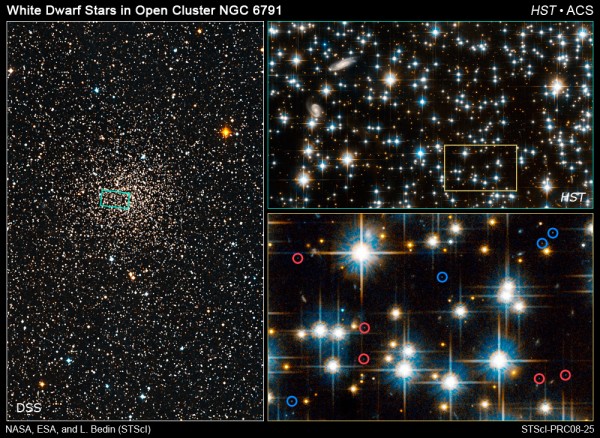
Stars, mass, and light: One of the wonderful things that astronomers have learned about stars is the relationship between the light they emit and how massive they are. Not surprisingly, the more massive a star is, the more light it typically emits. We've figured out what the relationship is, and we have not only uncovered the relationship between the mass of a star and how much light it gives off, we've also taken a census of how many stars are out there.
What is surprising in this regard is that -- on average -- our Sun is not typical. More than 90% of the stars in our galaxy (and in all galaxies) are less massive than our Sun, meaning they give off much less light than our Sun does. But this relationship is severe: a star half as massive as our Sun gives off only 10% of the light that our Sun does. All-in-all, it means that when we look at anything in the Universe that emits light -- stars, galaxies, clusters of galaxies, etc. -- we can figure out how much mass is there in the form of stars. (Please keep in mind that over 99% of the mass of our solar system is in our star.)
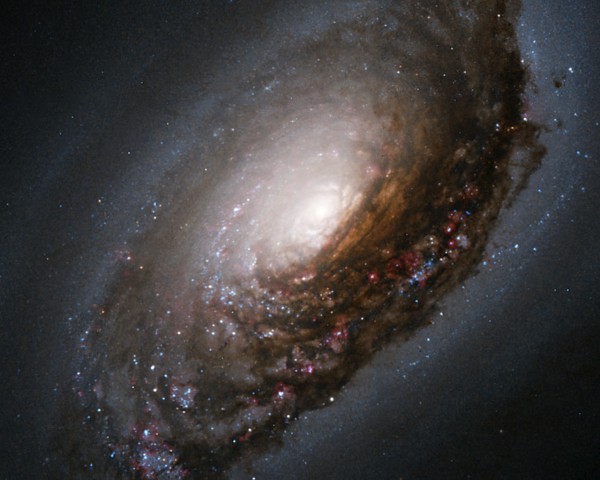
Gravity and mass: But measuring starlight isn't the only way we know of to find out how much mass is in something. We have another tool: gravity! Gravitationally, we have a number of different tools to measure how much mass is in something. For individual galaxies, we can look at how they rotate (or, for close enough galaxies, how individual stars move) and figure out how much mass there must be to hold them together. For clusters of galaxies, we can look at how the galaxies on the outskirts move about the center, like Fritz Zwicky did.
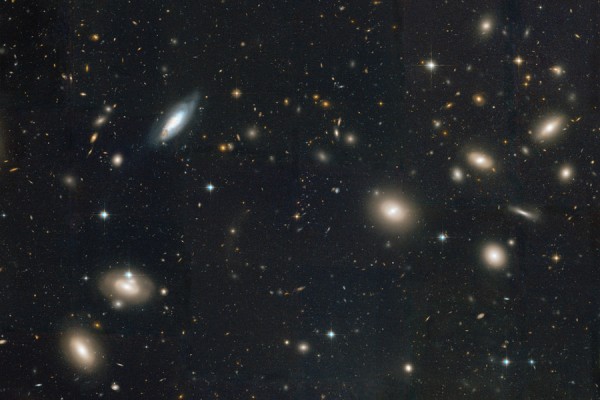
More Gravity: But there are more ways than just looking at velocities to measure the amount of mass in a galaxy or cluster with gravity. We can look at -- over the history of the Universe -- how quickly (and on what scales) objects collapse gravitationally, to form the structures we currently see in our Universe.
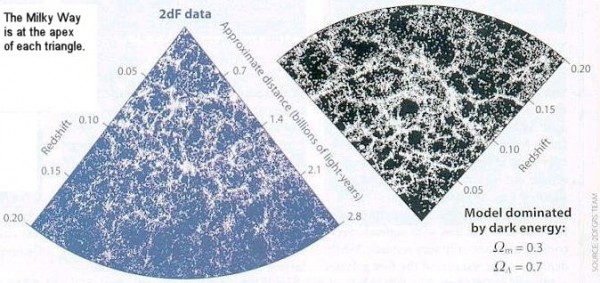
Gravitational Lenses: The Universe is also full of matter. Some of it's closer to us, and some of it's farther away. Every once in awhile, we'll find a cluster of galaxies in front of another galaxy. When this happens, the background galaxy can be lensed by the mass of the foreground cluster, the same way an optical lens can bend light. The distorted arcs in the image below are not only evidence of lensing, they are -- in many instances -- multiple images of the same background galaxy! They also allow us to measure how much mass is in the foreground cluster.
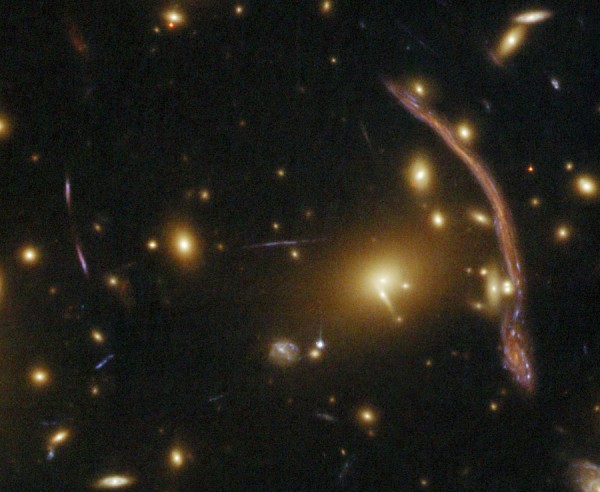
We can also look at the rate of expansion of the Universe. It's highly dependent on all of the energy in it, including normal matter, radiation, neutrinos, and any "dark" things that may exist.
Although there are other ways to measure mass gravitationally, these are the main ones. They all give the same answer, too: about 25% to 30% of the total energy in the Universe is some form of gravitational mass. But what of the stars? It turns out that stars are only about 0.5% of the mass in the Universe.

This is a difference of a factor of FIFTY!
So what we learn from this is that all the different ways we can measure gravitational mass give the same result. That result tells us that when we look at an image like this, and see all the light we see:
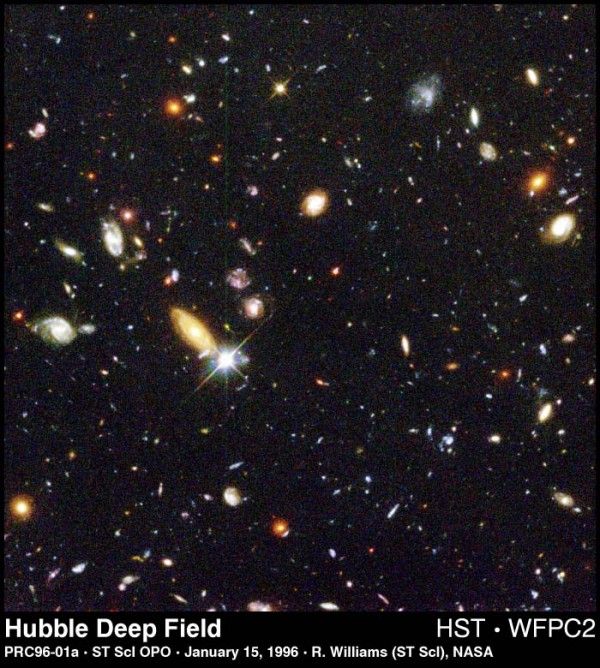
We're only seeing light from about 2% of the total mass. This leads us to one of only two conclusions: either there is a bunch of mass that is invisible to us or there is a different law of gravity for galaxies, clusters, and the Universe than we've currently considered. But right off the bat, we find that starlight is woefully inadequate to explain our observations. And we need a little more information to decide which of these two possibilities is correct, which we'll work towards in a few days in part II!

This is a great approach to even simpler scientific ideas. To start from the initial questions and retrace the process of question and discovery.
I think even laymen who are pretty well-versed in the dark matter problem have a lot to gain from this journey (I know I do). Perhaps this would be a great recurring series in which we get to trace scientific knowledge like one might diagram a sentence, replete with mistakes, misconceptions and the wonderful self-correcting nature of science.
Nice post, Ethan.
I enjoyed it. I'll be checking back in the near future for more.
Looking really forward to this, you convinced me of dark matter a while back with the colliding galaxies which separated wimp and regular matter.
I hope you continue that to dark energy, I'll have a much harder time with it as it still reads to me as "if our model is correct, than there needs to be dark energy".
I've always wondered how we're able to know all the things we do about the universe from observations taken at just one point (i.e. Earth) in the little amount of time that we've at it. It seems like the effects of gravitational lensing etc. would require multiple observation points to sort out.
Why would it be surprising that there is mass in the universe that does not emit appreciable light? If that's all that's meant by 'dark matter', it seems obvious that it exists (Phobos and Pluto don't emit much light, for instance).
Given that there is mass not emitting photons, why is it surprising that we know little of its nature? We observe via photons, after all. It would be nice to know if it is mostly diffuse (gas) or concentrated (black holes), but since we cannot observe it directly, or even indirectly with much resolution, it doesn't seem likely that we will learn much about it.
What, Ethan, no ambition? How about "well enough that it leads you to an argument that will change my mind." Go for the jackpot!
@D. C. Sessions: I don't see a problem with realistic goals. Perhaps that's why I'm not in management. ;-)
Reminds me of that piece you did on dark matter as a guest for Star Stryder. Really convincing, and intriguing. One thing that stood out to me was this "it is my determination that dark matter most likely exists". That's why I love your blog. Whereas a lot of scientists would suggest it MUST exist, you are open to all possibilities.
So thank you!
Robert @#6,
Your response is reasonable and your question is something I will definitely address as part of part 2.
Rory @#9,
I'm surprised anyone remembers that! Yes, I am a proponent of dark matter, but for (what I think are) good reasons. I'm very, very conservative when I come to my physics and astronomy, and I'll always blame conventional phenomena when it's plausible. Dark matter, though? We just can't account for it conventionally.
Waiting for chapter 2.
"Why would it be surprising that there is mass in the universe that does not emit appreciable light? If that's all that's meant by 'dark matter', it seems obvious that it exists (Phobos and Pluto don't emit much light, for instance)".
The problem is that the standard model for cosmological nucleosynthesis, which makes a wonderful job in explaining the abundances of the four or five lightest nuclei, sets an absolute upper bound for the amount of matter in the Universe which can be described within the standard elementary particle model, and this bound is about a fifth of the total matter we measure by gravitational bending of light, etc. So this "dark matter" (or at least, four fifths of it) has to be really weird.
@12 Esteban "The problem is that the standard model for cosmological nucleosynthesis, which makes a wonderful job in explaining the abundances of the four or five lightest nuclei, sets an absolute upper bound for the amount of matter in the Universe which can be described within the standard elementary particle model"
Really? I'd never heard that. Can you explain quickly what cosmological nucleosynthesis is? Is that the formation of stars etc. that happened at the big bang?
How do you get the 0.4% and 3.6% figure for stars/intergalactic gas figure? I see how you measure the mass of stars, but intergalactic gas?
@Anita: Close. It's the fusion reactions that happened before there were any stars, when the universe itself was still hot enough to slam nuclei together like that.
Great post Ethan - informative and illuminating ;)
15 @Naked Bunny
So there's a model based on the standard model for particle physics which describes the initial formation of the four or five lightest nuclei all throughout the universe, and according to that model there has to be an upper bound to the total amount of matter in the universe?
That's cool. I should look it up, I'd love to know how it works but I suppose it's too involved for a comment thread.
Obviously, you have not read and understood Fred I. Cooperstock's new book General Relativistic Dynamics: Extending Einstein's Legacy Throughout the Universe. As one important particular in this book, Cooperstock asserts, "Einstein's general theory of relativity, could account for the observed flat galactic rotation curves without the requirement for vast stores of mysterious dark matter." In other words, the entire idea that vast quantities of invisible "dark matter" are the dominant form of matter in our visible universe is flawed from its first conception; because it is based upon the incorrect assumption that Newtonian gravity is a sufficient gravitational theory at the galactic level. Cooperstock "wonders how different physics might have evolved had the early astronomers made themselves more knowledgeable about general relativity and made the kinds of calculations for galactic velocities that we have described in this book." To the layman and professional physicists, I must emphasize that Cooperstock describes the results of these difficult calculations (which he thoroughly references for the expert). This book is readable by the scientifically literate laymen but it must be read by professional physicists and astronomers who work in the area of dark matter; and who continue to inappropriately use the flat Newtonian gravitational approximation which is an inaccurate assumption at the galactic and cluster level. General relativity has to become the working knowledge of profesional physicists and astronomers; if they are not to continue misinterpreting the data and incorrectly concluding that dark matter is the most reasonable explanation of certain astronomical date.
This comment is by Thomas Neil Neubert, author of A Critique of Pure Physics
In re Cooperstock's book, it's said that if you read just one book on a subject, you know everything about it. Dare to read more than one, however, and things get more complex.
I know Fred Cooperstock's work! He wrote a paper here that I've read and analyzed.
My conclusion? His model is interesting in principle, but he applies it incorrectly. It is possible to have the thing he suggests, but it is not a galaxy.
Is there any evidence to suggest the amount of dark matter in the universe is increasing?
@Rich #21: No. Are you confusing "dark matter" with "dark energy" (two entirely different concepts which have been assigned stupidly confusing labels by cosmologists).